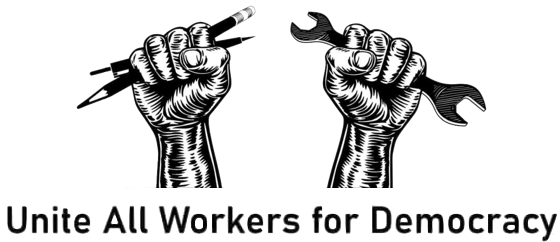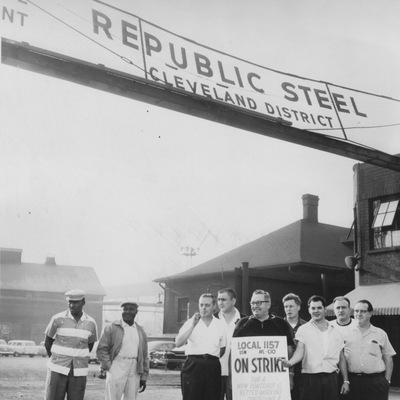Follow Erik Loomis on Twitter
This Day in Labor History: July 15. 1959. The Steel Strike of 1959 begins. Let’s talk about the fight to preserve the good lives for workers unions had won since World War II.
Perhaps the most underrated event in American labor history, the steel strike of 1959 touches on many of the key labor issues of the postwar period.
Combining the total number of workers and length of the strike, companies lost more employee hours than any other strike in American history. It showed the height of worker power in American labor history on the shop floor and through the contract.
It also demonstrated how the government would still bust strikes when it could — a blast from the past and a foretaste of the future.
Yet, it also suggested just how far unions had come in American society, given how the United Steel Workers of America (USWA) overcame these challenges and won. Finally, this was the end of the peak of American labor militancy.
During the 1950s, the nation’s major unions made enormous gains in wages and benefits for their members. That was particularly true of the United Auto Workers and, to a slightly lesser extent, the USWA. After Philip Murray died in 1952, David McDonald became union president.
McDonald is no one’s idea of the ideal union president, particularly given his total lack of charisma. There’s a reason no one talks about him today.
But he was good at forcing the companies to open up their pocketbooks in contract negotiations and forcing their hand on shop floor issues. He was irritated that the UAW generally won better contracts and worked hard to make up that gap.
During the 1950s, the USWA won significant wage gains, health insurance, pensions, vacation time, and other hallmarks of the working class becoming middle class through union contracts.
This often took place through strikes, including in 1946, 1949, 1952, and 1955. A 1956 strike was a major victory for the USWA (and for McDonald’s leadership), leading to big wage and benefit gains.
By 1959, the American steel industry was incredibly profitable, with very little foreign competition having developed by this time. But the companies wanted to push back.
Their specific line of attack was to take control of the shop floor through eliminating a section in the union contract that had given workers significant shop floor power through the grievance process.
Effectively, the USWA was using the grievance procedure to take away management prerogative to rule at the workplace. This included making it very difficult for companies to lay off workers whose jobs were replaced by automation.
While the high wages and benefits rankled the companies, it was the sheer gall of employees to tell them how to run their factories that really infuriated the steel industry. And so the companies decided their target would be the shop floor clauses, with the hope that this was a first step to regaining control over their workers.
Less than a month before the expiration of contract, and in the middle of ongoing negotiations, the companies offered a slight wage increase in exchange for union givebacks on scheduling, seniority, staffing, and work standards. The hope was to force the union to strike and then the companies would be willing to give up everything but shop floor control givebacks.
This strategy certainly worked at first. The USWA completely rejected the corporations’ offer. More than 500,000 workers went on strike at factories around the nation on July 15. Steel production declined 90 percent.
AFL-CIO president George Meany wasn’t happy with McDonald or the USWA. Being a Cold Warrior first and class warrior second, Meany worried the strike would undermine national security. He really wasn’t in a position to distance himself too far from one of the federation’s most powerful unions, so he gave it a very mild endorsement while pressuring McDonald to settle.
The strike convinced President Dwight Eisenhower to invoke the back to work clauses of the Taft-Hartley Act, forcing an 80-day cooling off period. This then led to the union filing suit in federal court that Taft-Hartley was unconstitutional. Unfortunately, the Court upheld the law by an 8-1 majority.
The strikers had to return to work after 116 days on the pickets. Yet the union was able to survive this frontal assault.
Kaiser Steel, which had long been more willing to work with labor than many of the other companies, caved and took out the offending provision while offering a small wage increase. But the rest of the companies held out.
Finally, Eisenhower realized the workers would strike again if the companies insisted on the workplace rule provision. He had then-Vice President Richard Nixon tell US Steel chairman David Blough to give up.
With the government clearly stepping in on the side of continued steel production, the companies did surrender. The contract created a committee for the union and management to study the issue of shop-floor rights.
One lesson of this strike for us is that the idea that the companies ever really accepted unionization, even at the peak of labor’s power, is a lie. There was never a period where the companies saw unions as partners. Rather, they wanted to crush them and return to the 1920s without union shops. The reason they couldn’t is worker power.
Corporations had to make public statements that they accepted organized labor as a partner. These were lies but they also reflected the need to appease that worker power.
The corporations may have lost the 1959 strike, but the union was not is a good position to win in the long run.
Ultimately, the rise of steel imports, which some have claimed were a result of consumers looking to foreign competition in order to avoid production problems because of these frequent labor conflicts, would undermine both the industry and the USWA.
The 1959 strike was the last nationwide steel strike of the era. In the 1962 contract, McDonald did give back quite a bit of shopfloor control and made it easier for companies to let workers go because of automation. He became convinced about that the steel industry was increasingly less competitive and hoped these compromises of worker power would help. They did not.
But they did create a rank and file rebellion against McDonald and in 1965, he was replaced by I.W. Abel, a very rare defeat for a major union leader to that point in labor history. But the American steel industry did not reverse its long, slow decline.

